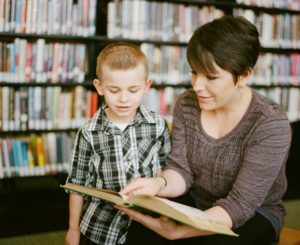With a few key tips, children will be motivated to add reading to their routines and parents will be empowered with these creative no-cost and low-cost strategies. Including all texts – fiction and nonfiction alike – provides endless opportunities for learning and enjoyment! The following recommendations may also be adjusted to fit your schedule – at home or on the go.
Tip 1: Model Reading for Enjoyment.
Children are interested in what they observe others doing for fun! Share silly stories and new learning from the text as you read, and ask the children to make a connection. Discussing the passage helps model how you think about it and you’re able to make adjustments to the meaning along the way. The best part is the flexibility of choosing a text that fits the moment: a comic strip or graphic novel, a young adult book, a magazine or newspaper article, a recipe, or an online version of your current favorite book. The key here is a low-stress approach. Provide words and add context, if needed. The positive experience of sharing the text with you will build skills and strategies, and your child will want to read again.
If you enjoy reading, they will too! In the same way a strong teacher makes a connection with the students on the emotional level to encourage learning, the children will feel your interest. The key to creating a lifelong reader that is intrinsically motivated is a positive emotional connection to reading. Parents’ passions can be shared and that enthusiasm is contagious.
Tip 2: Schedule Time for Social Reading.
Children love spending time together. When so much of our lives at school and work hinge on the use of technology, setting an appointment with your children to read together is something to look forward to. It isn’t about a solid hour of reading instruction, but instead, it’s a time of decreased interruptions to allow space and time for social reading. In as little as 15-30 minutes of shared reading, children grow as readers.

For younger children, the tried and true real-aloud is perfect. Make the book engaging with character voices and stop often for discussion to ask why the characters did that, how does the character feel, and of course, what will happen next. Take your favorite books to the next level and act the scenes out together.
Older children still enjoy being read to, and the teacher read-aloud is always a favorite time in classrooms across the nation. Adults reading aloud help model fluency, vocabulary, and comprehension skills. When sitting side-by-side, children gain print awareness, as well. After shared reading experiences, opportunities to connect the text to other experiences, texts, and media present themselves. This helps further model how to link prior knowledge to independent reading strategies.
Form a “book club” with your teenage readers. Books can be quite social. Let your teen choose the book and set a discussion time each day. Again, it’s valuable to discuss the character’s motivation, the feelings that are driving the plot, and of course, predict what will happen next.
During this time of social distancing, engage extended family members too. Digital tools and platforms, including FaceTime and ZOOM, are simple ways to connect and share the love of reading.
Tip 3: Dinner and a Show
Building positive reading experiences can happen in many forms. The emotional connection of shared reading will help create lifelong readers, but the reading experience isn’t limited to books. Try board games like Scrabble, Pictionary, Monopoly, and Life. Family game night involves reading and discussion as well as many soft skills that require practice to become habits. Learning how to take turns, looking others in the eyes, and respecting others are additional benefits to playing games. Reading game cards and directions, as well as discussions explaining related comprehension (predictions of game moves, summaries of results), offer valuable reading skill rehearsals.
Tip 4: Audiobooks
What are the odds that children finish virtual learning assignments at the precise moment parents wrap up work for the day? The probability is probably low. Audiobooks paired with texts – either hard copy or digital – allow reluctant readers the chance to follow along. The multisensory experience of reading is powerful because it incorporates “see it” and “hear it” simultaneously. Audiobooks also model fluency, including pacing, inflection, and phrasing. Listening to reading is appropriate for all readers Because it is supported reading, it increases access to interesting texts regardless of the reader’s independent literacy skills.
Tip 5: Make Reading Authentic
Reading is an essential part of daily life, so encourage children to recognize and participate in reading throughout the day. Making dinner? Invite children to read the recipe, identify the ingredients, and enjoy the fruits (or casseroles) of their labor. Additional authentic reading opportunities include closed-captioning on videos and television shows, instructions on how to build a model or complete a project, and directions to playing a new game. Reading support may be needed in these activities, but the tangible results are incredibly motivating and esteem-building for children.
Tip 6: Keep the Content, Change the Form
Select a book that has been made into a movie. After the book has been read and discussed, schedule a family movie night complete with themed snacks to pair with and reflect the books. Do you have a favorite book that doesn’t have a feature film? Work together on a project to make the movie trailer using digital tools such as iMovie. This is a golden opportunity to reread the text in an effort to capture a summary in a few snippets of video. Even without technology, children can create a storyboard of illustrations highlighting key characters and events from the story. Extend into writing, as well, by encouraging creativity in developing a reader’s theater script which could be a summary or an adaptation of a scene from the book. Keeping the story intact while changing the format allows students to reflect their understanding of key story elements while highlighting their creativity.
Time spent reading and discussing books together is an investment in your child’s future. As noted by Dr. Louisa Moats (2020), “As early as kindergarten, how well students acquire foundational reading skills predicts their reading comprehension into high school.” The goals in accessing the higher processes of reading include comprehending the text, drawing conclusions based on what is read, and connecting to your related life experiences. Both strong and struggling readers benefit from listening to reading, reading aloud, and independent reading. Throughout virtual learning, seek opportunities to model, share, and encourage reading.
References
Moats, Louisa C. and Brady, Susan. (2020). Speech to Print: Language Essentials for Teachers.Paul H. Brookes Publishing Co.
About the Authors

Ginny Simank

Cindy Nicodemus
Ginny Simank is a Level 4 IMSE OG Master Instructor living in Dallas, Texas. She has a master’s degree (M.Ed.) with a Reading Specialist certificate and holds certifications in special education, English as a Second Language, and generalists for Early Childhood through 6th grade & ELA 4th-8th grades. She is an IDA-certified Structured Literacy Teacher and full-time instructor for the Institute for Multi-Sensory Education (IMSE), whose mission is to train others across the country (teachers, administrators, tutors, education professionals & parents) in the Orton Gillingham methodology of multi-sensory language instruction. Ms. Simank previously served on the national board of directors for the Learning Disabilities Association and was a member of the LDA’s Education & Nominating Committees.
Cindy Nicodemus is a CALT and educator living in Dallas, Texas. She holds a Bachelor of Science degree in Education and certifications in generalists Early Childhood – 8th grade, Gifted and Talented, and English as a Second Language. Currently, Mrs. Nicodemus uses Orton-Gillingham in her classroom and tutors students of all ages.
Sign up for our LIVE virtual Orton-Gillingham training! We are now offering half-day, evening, and weekend options to best fit your schedule.
The IMSE approach allows teachers to incorporate the five components essential to an effective reading program into their daily lessons: phonemic awareness, phonics, vocabulary, fluency, and comprehension.
The approach is based on the Orton-Gillingham methodology and focuses on explicit, direct instruction that is sequential, structured, and multi-sensory.
It is IMSE’s mission that all children must have the ability to read to fully realize their potential. We are committed to providing teachers with the knowledge and tools to prepare future minds.
